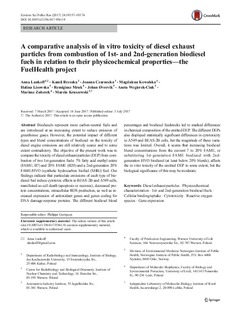A comparative analysis of in vitro toxicity of diesel exhaust particles from combustion of 1st-and 2nd-generation biodiesel fuels in relation to their physicochemical properties-the FuelHealth project
Lankoff, Anna; Brzoska, Kamil; Czarnocka, Joanna; Kowalska, Magdalena; Lisowska, Halina; Mruk, Remigiusz; Øvrevik, Johan; Wegierek-Ciuk, Aneta; Zuberek, Mariusz; Kruszewski, Marcin
Peer reviewed, Journal article
Published version
Permanent lenke
http://hdl.handle.net/11250/2494732Utgivelsesdato
2017Metadata
Vis full innførselSamlinger
- Artikler [5063]
- Publikasjoner fra CRIStin FHI [7538]
Originalversjon
Environmental science and pollution research international. 2017, 24 (23), 19357-19374. 10.1007/s11356-017-9561-9Sammendrag
Biodiesels represent more carbon-neutral fuels and are introduced at an increasing extent to reduce emission of greenhouse gases. However, the potential impact of different types and blend concentrations of biodiesel on the toxicity of diesel engine emissions are still relatively scarce and to some extent contradictory. The objective of the present work was to compare the toxicity of diesel exhaust particles (DEP) from combustion of two 1st-generation fuels: 7% fatty acid methyl esters (FAME; B7) and 20% FAME (B20) and a 2nd-generation 20% FAME/HVO (synthetic hydrocarbon biofuel (SHB)) fuel. Our findings indicate that particulate emissions of each type of biodiesel fuel induce cytotoxic effects in BEAS-2B and A549 cells, manifested as cell death (apoptosis or necrosis), decreased protein concentrations, intracellular ROS production, as well as increased expression of antioxidant genes and genes coding for DNA damage-response proteins. The different biodiesel blend percentages and biodiesel feedstocks led to marked differences in chemical composition of the emitted DEP. The different DEPs also displayed statistically significant differences in cytotoxicity in A549 and BEAS-2B cells, but the magnitude of these variations was limited. Overall, it seems that increasing biodiesel blend concentrations from the current 7 to 20% FAME, or substituting 1st-generation FAME biodiesel with 2nd-generation HVO biodiesel (at least below 20% blends), affects the in vitro toxicity of the emitted DEP to some extent, but the biological significance of this may be moderate.
